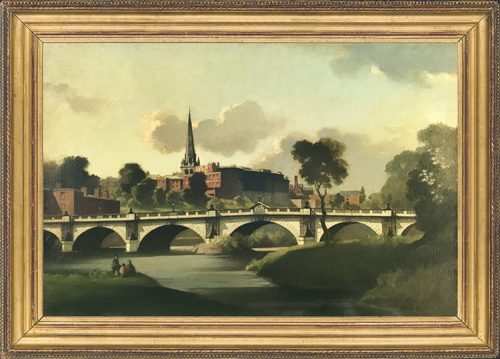Nicholls often uses bridges to orchestra his views of towns and cities within the landscape [see his painting of the Ponte di Pietra, Verona]. This compositional motif allows him to separate the town from the spectator, lending it a sense of romantic and ideal isolation – even here, where this sense is undercut by the uncompromising bulk of factories and chimneys. The slanting run of arches which divide the unspoilt green banks from the redbrick city recalls Canaletto’s paintings of bridges over the Thames; this 18th century twist on the view is reinforced by the little group of men on the left-hand bank, who might have walked out of one of Canaletto’s own riverscapes. It gives added complexity to Nicholls’s work, as though he were painting Shrewsbury and its surroundings through time, and is another aspect of his concern with the classical and permanent in the landscape. Beautifully lit, the cloudscape is touched with meltingly warm pastels, again recalling Canaletto’s views of the Thames.
Biographical details
Bertram Nicholls (1883-1974) was born at Didsbury, son of a Manchester businessman. He trained with Reginald Barber, a local portrait painter, and then for three years at the Slade, ‘but two of those years, he maintains, were wasted.’ In 1904 he studied Velasquez in Madrid; on his return he worked with Frederick Jackson, one of the Staithes Group of artists [see John William Howey], with whom he learnt landscape painting en plein air. In 1911 he met the New York artist Frank Mura and later settled in Sussex, very near Mura, whose work was a formative influence on his own art; two further important influences were Reynolds and Richard Wilson.
Nicholls exhibited at the Royal Academy from 1912; from 1923-34 he was president of the Manchester Academy of Fine Arts, and in 1931 was elected president of the Royal Society of British Artists. His first one-man show (a sell-out) was held at Barbizon House in 1924; he exhibited there in 1926, 1928 and 1932; in 1933 he had his first exhibition of watercolours at the Fine Art Society.
Works in public collections include San Giovanni Nepomuceno (Maidstone Museum & Art Gallery); Rochester Castle (Bradford Museums & Galleries); Quay in Italy (Southend Museum Service); Chepstow Castle and The Bridge (both Worthing Museum and Art Gallery); Riverside town (Brighton & Hove Museums & Art Galleries); Lancing Chapel (Towner Art Gallery); and others in Aberdeen Art Gallery and Museums; Adelaide, Art Gallery of South Australia; New Zealand, Auckland Art Gallery; Birmingham Museum and Art Gallery; Bristol City Museum & Art Gallery; National Gallery of Ireland; Liverpool, Walker Art Gallery; London, British Museum, Guildhall Art Gallery and Tate; Manchester City Art Gallery; Montreal Museum of Fine Arts; National Gallery of Canada; Preston, Harris Museum and Art Gallery.
See the RSBA publication of his work – Bertram Nicholls (1883- ), Frank Rutter, 1935, ed. of 750 – which quotes Nicholls extensively from articles in The Artist, VI, nos 1-6, Sept.-Dec. 1933 & Jan.-Feb. 1934. See also Painting in Oils by Bertram Nicholls, The Studio Publications, 1945.


